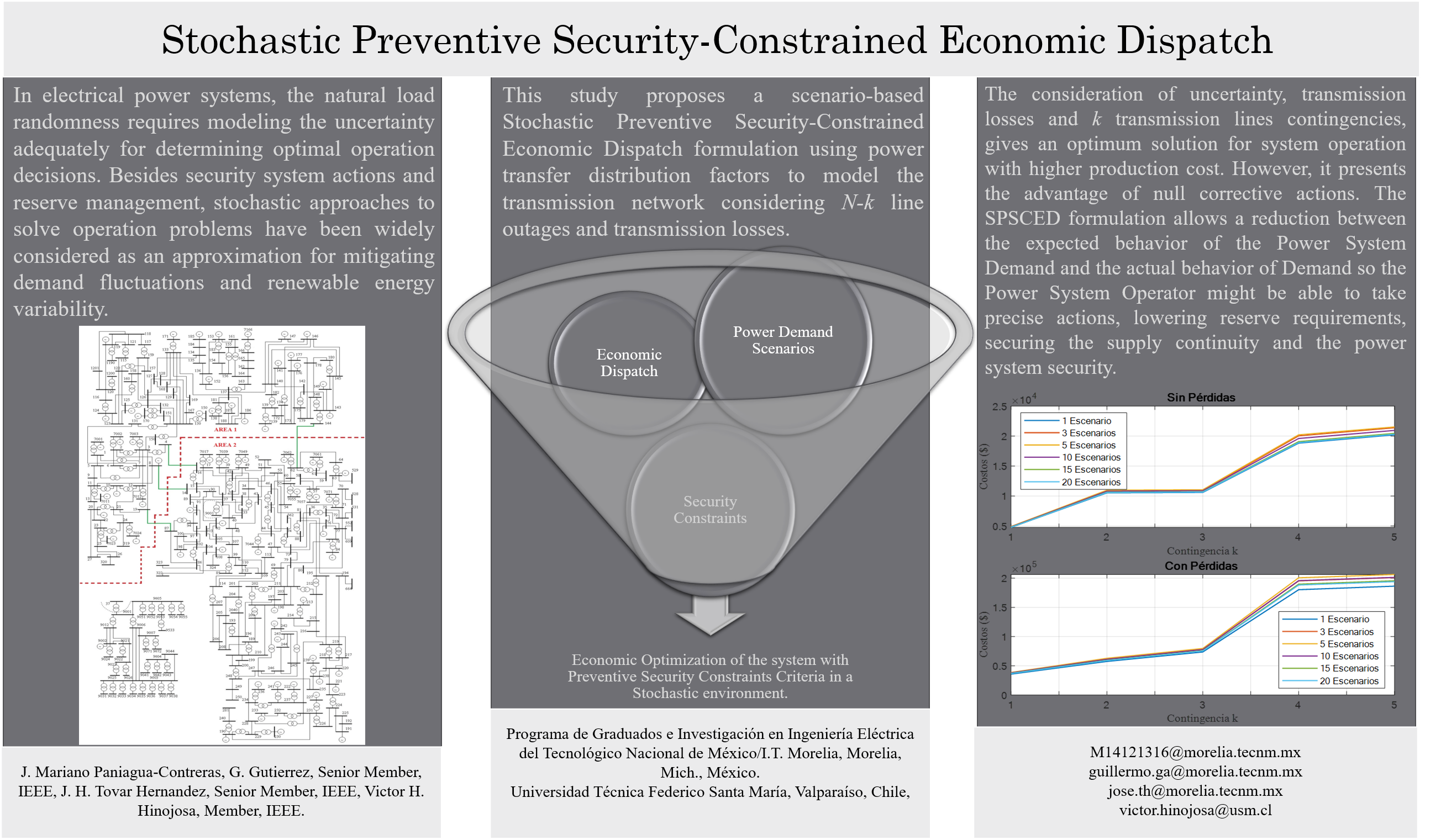Stochastic Preventive Security-Constrained Economic Dispatch
Keywords:
Economic Dispatch, Optimal Power Flow, Stochastic Programming, PTDFAbstract
In electrical power systems, the natural load randomness requires modeling the uncertainty adequately for determining optimal operation decisions. Besides security system actions and reserve management, stochastic approaches to solve operation problems have been widely considered as an approximation for mitigating demand fluctuations and renewable energy variability. This study proposes a scenario-based Stochastic Preventive Security-Constrained Economic Dispatch formulation using power transfer distribution factors to model the transmission network considering N–k line outages and transmission losses. Extensive computational simulations have conducted with different electrical power systems to demonstrate improvements in the power system operation obtained by the proposed stochastic formulation.
Downloads
References
Mehrtash, M., Raoofat, M., Mohammadi, M., and H. Zareipour, “Fast stochastic security‐constrained unit commitment using point estimation method,” International Transactions on Electrical Energy Systems, vol. 26, no. 3, pp. 671-688, 2016.
D. Bienstock, M. Chertkov, and S. Harnett, “Chance-constrained optimal power flow: Risk-aware network control under uncertainty,” Siam Review, vol. 56, no. 3, pp. 461-495.
I. G. Marneris, P. N. Biskas, and A. G. Bakirtzis, “Stochastic and deterministic unit commitment considering uncertainty and variability reserves for high renewable integration,” Energies, 2017, 10, 140.
L. Roald, G. Andersson, S. Misra, M. Chertkov, and S. Backhaus, “Optimal power flow with wind power control and limited expected risk of overloads,” in Proc. 2016 Power Systems Computation Conference (PSCC), Genoa, Italy, 2016, pp. 1–7.
O. Alsac and B. Stott, “Optimal load flow with steady-state security,” IEEE Trans. Power Apparatus and Systems, vol. PAS-93, no. 3, pp. 745–751, May 1974.
Federal Energy Regulatory Commission, “Security constrained economic dispatch: definition, practices, issues and recommendations,” Tech. Rep., 2006.
L. S. Vargas, V. H. Quintana, and A. Vannelli, “A tutorial description of an interior point method and its applications to security-constrained economic dispatch,” IEEE Trans. Power Systems, vol. 8, no. 3, pp. 1315–1324, Aug. 1993.
Z.-L. Gaing, and R. F. Chang, “Security-Constrained economic scheduling of generation considering generator constraints,” in Proc. 2006 International Conference on Power System Technology, Chongqing, China, 2006, pp. 1–7.
Victor H. Hinojosa, “Comparing corrective and preventive security-constrained DCOPF problems using linear shift-factors,” Energies 2020, 13, 516.
A. Monticelli, M. V. F. Pereira, and S. Granville, “Security-constrained optimal power flow with post-contingency corrective rescheduling,” IEEE Trans. Power Systems, vol. 2, no. 1, pp. 175–180, Feb. 1987.
Victor H. Hinojosa and Francisco Gonzalez-Longatt, “Preventive security-constrained DCOPF formulation using power transmission distribution factors and line outage distribution factors,” Energies 2018, 11, 1497.
A. Pitto, D. Cirio, and E. Ciapessoni, “Probabilistic security-constrained preventive redispatching in presence of correlated uncertainties,” in Proc. 2020 AEIT International Annual Conference (AEIT), Catania, Italy, Italy, 2020, pp. 1–6.
H. Li, Z. Zhang, X. Yin, and B. Zhang “Preventive security-constrained optimal power flow with probabilistic guarantees,” Energies 2020, 13, 2344.
J. R. Birge and F. Louveaux, “Introduction to stochastic programming.” Springer Science & Business Media.
F. Bouffard, F. D. Galiana, and A. J. Conejo, “Market-clearing with stochastic security-part II: case studies,” IEEE Trans. Power Syst., vol. 20, no. 4, pp. 1827–1835, Nov. 2005.
L. Wu, M. Shahidehpour, and Z. Li “Comparison of scenario-based and interval optimization approaches to stochastic SCUC,” IEEE Trans. Power Syst., vol. 27, no. 2, pp. 913-921, May 2012.
O. Mégel, J. L. Mathieu, and G. Andersson, “Hybrid stochastic-deterministic multiperiod DC optimal power flow,” IEEE Trans. Power Syst., 32(5), 3934-3945.
O. Mégel, Storage in Power Systems: Frequency Control, Scheduling of Multiple Applications, and Computational Complexity (Doctoral dissertation, ETH Zurich), 2017.
M. Wafaa and L.-A. Dessaint, “Multi-objective stochastic optimal power flow considering voltage stability and demand response with significant wind penetration,” IET Generation, Transmission & Distribution, vol. 11, no. 14, pp. 3499–3509, 2017.
M. Rowe, T. Yunusov, S. Haben, W. Holderbaum, and B. Potter, “The real-time optimisation of DNO owned storage devices on the LV network for peak reduction,” Energies, 7(6), 3537-3560.
Hui Zhang, Vijay Vittal, Gerald Thomas Heydt, and Jaime Quintero, “A mixed-integer linear programming approach for multi-stage security-constrained transmission expansion planning,” IEEE Trans. Power Syst., vol. 27, no. 2, pp. 1125-1133, May 2012.
https://www.cenace.gob.mx/Paginas/SIM/Reportes/PronosticosDemanda.aspx
https://www.fico.com/es/products/fico-xpress-optimization
Fangxing Li, Rui Bo, “Small Test Systems for Power System Economic Studies,” 2010 IEEE PES General Meeting, pp. 1-4
Case IEEE 300.” [Online]. Available: https://www.pserc.cornell.edu/matpower/docs/ref/matpower5.0/case300.html.


